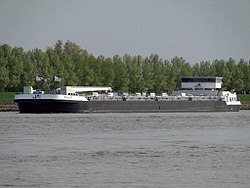Amulet (ship)
|
Bunker ship Amulet
|
||||||||||||||
|
||||||||||||||
|
||||||||||||||
|
||||||||||||||
|
||||||||||||||
|
||||||||||||||
The inland vessel Ecotanker Amulet is a double-hull type C ship for the transport of bunker oil and the first diesel-electric tanker in the Rhine area. The hull was built in Nantong (China) and equipped at Holland Shipyards in Hardinxveld-Giessendam . The christening of the ship took place on November 7, 2010.
construction
Great emphasis was placed on environmental compatibility during construction . The complete drive system is a new development by D&A Electric from Ridderkerk , the so-called Eprop system . The entire machine installation, consisting of four Volvo - diesel generators located in the bow. It is driven by two Veth L drives with electric motors of 850 kW each at 1800 rpm. The drives are 2.714: 1 stocky and adjustable in height to 64 cm. The propellers with a diameter of 1600 mm run in nozzles that guide the water jet slightly downwards.
Thanks to the height adjustability, no ballast water is required when the ship is empty. The empty ship lies on a level keel. The shape of the tail has been adapted to the new drive. In addition to the electric bow thruster , two hydraulic head rudders are built in, which means that the bow thruster is used less often. The rudders can be lowered one meter and are arranged in a V shape. The drive motors comply with the Euro 6 standard and are equipped with an exhaust gas cleaning system. The carbon dioxide emissions are 30 percent lower than with comparable ships, the fine dust emissions are zero and those of nitrogen oxide are low, as the exhaust gases are cleaned by means of urea injection .
In addition to the heating system for the cargo, the encapsulated harbor diesel generator, the frequency converters and electric motors, tanks for gas oil , lubricating oil , fresh water, waste water and ballast tanks are installed in the stern .
technology
- Engines = Volvo D16 MG / HCM 534 F
- Generators = Stamford HCM-634-G, 713 kVA / 650 kW
- Bow thruster = Veth-Jet four-channel 1400
- 20 cargo tanks
- Bunker mast approx. 40 meters
- Pump output = 2000 m³ / h
Eprop system
The ship is propelled by two electric rudder propellers from Veth Propulsion (L-drive). The propellers run in nozzles and can be adjusted in height depending on the load. The water jet is inclined slightly downwards. The electric drive motors have an output of 850 kW each and are frequency-controlled. At just 800 rpm, the propellers can convert their full power into thrust. When the water resistance decreases, the force control increases the speed of the electric motors via the frequency until the full output of 850 kW is reached again. The propellers are designed so that they can transmit full power at any speed.
With the control levers, the speed of the propellers is no longer changed as usual, but the required drive power. If, for example, a power output of 300 kW is set, the power control searches for the appropriate propeller speed. If the driving resistance increases due to the current, water depth or headwind, the speed is automatically reduced. If more power is now to be transmitted to the propellers, the system first checks whether the generator can provide this power. If this is not the case, it reports to the skipper that another generator is required, which is then started and switched on at the push of a button.
Four Volvo D-16 diesel generators, each with 500 kW at 1800 rpm, are installed in the forecastle for the propulsion, the loading / unloading pumps, the bow thruster and the on-board electrical supply. A rotating converter generates the voltage and frequency required for the vehicle electrical system. As soon as one or more main generators are started, the harbor generator is automatically switched off.
Conclusion
Thanks to the new drive system and the optimized hull shape, the Amulet uses around 25 percent less fuel than a comparable conventional ship. The engines already meet the legal requirements for 2022. The Amulet was named Ecoschiff of the year 2011.
Individual evidence
- ↑ Pictures of the L-drive
- ↑ [1] Eco-Ship of the Year 2011
swell
- Information about the ship (Dutch)
- Report on ship technology (Dutch)

